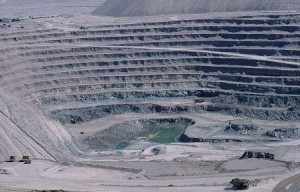Biomining- An Introduction
This is a continuing series of articles on Biomining. This is part 1 of the series.
 Mining is one of the oldest economic activities and the technology employed to extract minerals have not changed much over the years. The crude ore is dug out from the earth, crushed and the economically important minerals are then extracted from it by either using chemical treatment or heat. The environmental and health hazards of traditional mining technologies are negative and therefore to confront this problem, bioleaching processes have been developed for extracting different minerals from their respective ores.
Mining is one of the oldest economic activities and the technology employed to extract minerals have not changed much over the years. The crude ore is dug out from the earth, crushed and the economically important minerals are then extracted from it by either using chemical treatment or heat. The environmental and health hazards of traditional mining technologies are negative and therefore to confront this problem, bioleaching processes have been developed for extracting different minerals from their respective ores.
When microorganisms are employed to extract minerals from the tailings and ores, the process is called biomining/ microbial mining. Metals are first solubilised which is leaching carried out by microbes in biochemical waste and then separated by sedimentation. It is not very costly and highly useful for river and low grade ores. It also doesn’t release much tailings during extraction of metals from their respective ores. Metals can also be recovered from tailings discharge by smelting the ores.
Leaching is the solubilisation of metals from ores, as microorganisms are used to solubilise metals, it is popularly known as Bioleaching or Biological Mineral Leaching. It was used for the first time in the 18th century in Rio Tinto mines for the extraction of copper from its ores. The microorganisms leach out the metal in the form of metal salt. Nowadays, it is employed for the recovery of metals from low grade ores and solid waste refuse (tailings) and it can be used both inside and outside of the mines.
One project currently under investigation is the use of biological methods for the reduction of sulphur in the coal-cleaning applications from in-situ mining to mineral processing and treatment technology, biotechnology provides is with innovative and less costly solutions that can easily be adopted by the industry. At first, the role of bacteria in extraction of copper from its ores went unrecognised but now they are being used to recover millions of tonnes of copper. Around 10% of copper ore is recovered by use of bioleaching process.
Bioleaching applications also help in reduction of pollution. For many years, the only microorganism recognised for leaching of metals form their ores was Thiobacillus ferro-oxidans but now many other microorganisms are also used.
Rock eating microorganisms are said to be chemo-lithotrophs, they obtain their energy from the oxidation of inorganic materials. These small servants of man are highly useful and have enormous application in future especially in leaching of metals.
Some microorganisms involved in Biomining-
1. Thiobacillus ferro-oxidans (for Cu, Co, Ur, Ni, Zn, PB)
2. Thiobacillus acidophilus (Fe and Cu)
3. Thiobacillus organoparpus (Fe and Cu)
4. Thiobacillus thioxidans (Zn and Pb)
5. Leptospirillum ferrooxidans (Fe and Cu)
6. Sulfilolus acidocalcarius (Fe, Cu and Mo)
Advantages of Bioming-
1. More economic and requires less energy.
2. Highly useful for low grade ores.
3. Can be used both inside and outside the mines.
4. Eco-friendly and reduces pollution.
Disadvantage-
1. Very slow process.
Read Part 2


